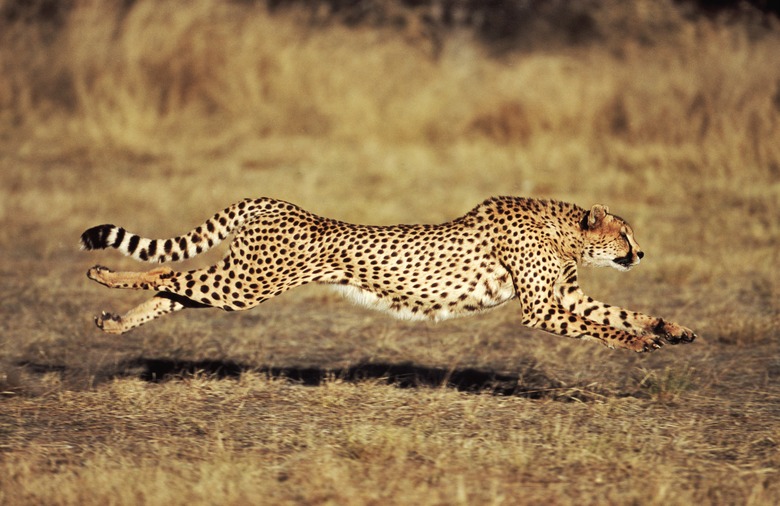How Fast Does A Cheetah Run?
The cheetah is a member of the cat family and by far the fastest animal on land. One of the reasons that it needs to be so quick is that its favorite food, the gazelle, is also one of the speediest land animals on the planet. Cheetahs are tan with round black spots, have a white underbelly, and sport trademark black "tear marks" that run from under the eyes down to the mouth.
The Fastest Animal Time Frame
The Fastest Animal Time Frame
A cheetah run speed can get up to 76 miles per hour, but they can only sustain them for over a distance of approximately 1,500 feet. Cheetahs can accelerate at an amazing rate, going from a standstill position to as fast as 68 mph in less than three seconds.
The record for the fastest cheetah sprint time on Earth belongs to a cheetah named Sarah who lives at the Cincinnati Zoo. She ran 100 meters in 5.95 seconds in 2015, which beat her old record of 100 meters in 6.13 seconds. This converts to ~61 mph, which is the average speed of a car on a freeway. And, remember, this is simply the most accurately measured record. It's estimated that cheetahs can reach speeds of 76 mph.
To put that in perspective, the fastest sprinter in the world, Usain Bolt, ran that same 100 meter dash in 9.58 seconds, which converts to 28 mph. The average person who isn't an Olympian like Mr. Bolt sprints that distance in 14 seconds, which converts to ~15.9 mph.
Function
Function
The cheetah uses its amazing cheetah run speed to hunt. It stalks it prey visually and attempts to get as close as it can before running after it. Cheetahs then will trip up the animal, most often a gazelle, and grab it by the throat, suffocating it or severing an artery.
Features
Features
Cheetahs have evolved over the years into the fastest land animal with a number of adaptations.
The cheetah has an enlarged heart and lungs that enable it to take in lots of oxygen and circulate it in a very effective manner. The nostrils of the cheetah are also larger than most animals its size. Those adaptations allow the cheetah to take in ample oxygen to power their muscles efficiently to create maximum power and speed.
The body structure also contributes to their speed. Cheetahs have small heads, thin waists and long thin bodies. This keeps them streamlines and aerodynamic to maintain top speeds.
The cheetah also has long and powerful legs. It also has semi-retractable claws that allow it to gain more ground with every step. The cheetah's tail acts like a rudder as it runs that allows it to keep balance and maneuver while sprinting at top speeds.
Geography
Geography
Cheetahs live in the parts of Africa that have habitats ranging from semidesert and savanna to high grasslands and even mountainous regions. The range of the cheetah is much smaller now than it has been in the past. Cheetahs once could be found all through the continent of Africa and into Asia as far as India, but now are limited to portions of eastern and southwestern Africa with a small and isolated population living in Iran.
Considerations
Considerations
Cheetahs must cool down after they hunt if they expend too much energy running. Getting to such high speeds puts a tremendous toll on their bodies with their body temperature rising to dangerous heights. You'll often see them lounging in the shade after sprinting or running.
Cheetahs have to consume their meal quickly as they are the smallest of the "big cats" and can have their kill taken from them by lions, leopards and hyenas.
Cite This Article
MLA
Lindell, John. "How Fast Does A Cheetah Run?" sciencing.com, https://www.sciencing.com/how-fast-does-cheetah-run-4577113/. 22 November 2019.
APA
Lindell, John. (2019, November 22). How Fast Does A Cheetah Run?. sciencing.com. Retrieved from https://www.sciencing.com/how-fast-does-cheetah-run-4577113/
Chicago
Lindell, John. How Fast Does A Cheetah Run? last modified March 24, 2022. https://www.sciencing.com/how-fast-does-cheetah-run-4577113/
